#AngularJS vs React JS vs Node JS
Explore tagged Tumblr posts
Link
#reactjs development company#AngularJS vs React JS vs Node JS#difference between angular JS React JS Node JS
0 notes
Photo

Angular JS vs. Node JS vs. React JS: Which Would Be Best? ☞ http://bit.ly/2oJOOxY #angularjs #javascript
2 notes
·
View notes
Text
Let us examine the distinction between MEAN and MERN stacks

A great way to fully comprehend full-stack development is to build a custom web application. The distinction between a mean stack and a mean stack must be understood when deciding which technology stack is best for a web development project.
Furthermore, big data advancements have thrust agile methodologies into the spotlight. The infrastructure of modern software programmes must be strong in order to adapt to the dynamic business environment. The stack that maximises flexibility, scalability, and performance while remaining cost-effective must therefore be chosen by developers. They should be fully informed of the advantages and disadvantages of each option before making their choice. But first, let's give beginners an introduction to full-stack development.
Full-stack development: What is it?
In the context of web development, "full stack" refers to the front-end, back-end, testing, and mobile app software systems. Traditionally, businesses hired people with expertise in any of these fields. However, there is a high demand for qualified candidates in ancillary technologies as the needs of modern workplaces change.
Mean Stack vs. Mern Stack
Due to the fact that both frameworks provide trustworthy abstraction at the UI level, the competition between the MEAN and MERN stacks is quite close. While Mern Stack uses the ReactJS library, a Facebook product, Mean Stack makes use of AngularJS, which is supported by Google Inc. By using JavaScript as the main programming language, code switching is avoided, and new developers are given the tools necessary to materialise their concepts.
Both options offer a fantastic set of tools that can be used to create software products that work well. Therefore, selecting the appropriate stack for their applications can be overwhelming for newcomers. Let us examine their advantages more closely and contrast how well they perform in various scenarios.
What is Mean Stack and why should you use it?
One of the rapidly expanding open-source development frameworks, Mean Stack, enables programmers to quickly and easily create complex web applications. The phrase "mean stack" refers to a collection of JavaScript-based frameworks used to create sophisticated web applications. A combination of MEAN Stack technologies, including MongoDB, Express.JS, Angular, and Node.JS, is used in mobile and web applications.
The need for technology has given developers the green light to work on the front-end, back-end, and much more. Today's developers are capable of understanding and resolving issues in a variety of software development streams. Software development firms are now cautiously looking to hire "mean stack" developers who can completely build the website or application from scratch without stopping.
Recent years have seen an exponential growth in web development technologies. Front-end technologies like AngularJS, Node JS, React JS, and others have replaced back-end development technologies like Java, PHP, and others. These technologies have undergone continuous development since their inception in order to increase coding effectiveness and decrease code size. One such group of tools that has significantly cut down on development time is the MEAN stack.
The primary advantage of using the MEAN stack is that all of the coding is JavaScript-based. This shortens the amount of time a novice developer must spend learning. A lightweight application architecture and a quick turnaround time have also become essential due to the global boom in the start-up culture. MEAN Stack aids in meeting this requirement. The JavaScript engine used by the entire programme, including the web application server, is based on Chrome. This decreases the overall amount of memory needed and speeds up web response time.
In addition to the advantages listed above, the MEAN stack has lower development costs. Additionally, MEAN.JS is completely open source and free to use, as is its extensive ecosystem. Because of its sharing capabilities, which make extensive code reuse and sharing within the stack possible and lower overall costs. It might be one of the main advantages of using MEAN for business. The development time can be shortened, resulting in a lower development cost, thanks to its unified and flexible offerings.
The MEAN stack also aids in scalability and quick MVP development. A productive platform for creating scalable software products is the MEAN stack. The stack contains a sizable number of additional frameworks, libraries, and reusable modules that enable businesses to accelerate development more effectively. Therefore, MEAN stack can be a great option for start-ups due to its shorter development cycles and lower development costs by helping to deliver modern and ready-made solutions, which can significantly save time while making development less strenuous.
Here is a brief description of the mean stack components:
AngularJS is the front-end framework that runs the code in the user's browser.
NodeJS is a runtime system that implements JavaScript on the backend of a web application.
ExpressJS is the back-end application that runs on top of NodeJS.
MongoDB: It is used to store the data of back-end applications as JSON files.
MERN: Why?
The MERN stack's main selling point is that it is a platform that offers businesses and enterprises the agility, performance, and intelligence they require to advance their operations. JavaScript is at the core of many technologies that enable developers to build and deliver websites with rich experiences similar to desktop and mobile apps because all web users today demand high levels of performance and interactivity.
JavaScript has evolved into a web interface. It has changed significantly over the years. Today, JavaScript is used for much more than just adding visual effects to websites; it also aids in the implementation of application logic and database access.
Due to a few benefits, MERN Stack is also securing a small place in the world of the software developer. There is no need for context switching because every line of code is written in JavaScript. In traditional tech stacks, the challenge for developers was figuring out how to integrate different programming languages into one another in order to turn their ideas into usable products. But compared to earlier times, the present is a significant departure. As the JavaScript stack has improved, things are now more balanced. Developers can only use JavaScript and JSON when using the JavaScript stack (JavaScript Object Notation). Additionally, this stack excels at creating highly effective web applications.
No templates exist for the language. React is a popular programming language despite not being one of the hottest or most in-demand ones because it lacks templates. React is sometimes more frequently used by web developers than other languages because it eliminates the need to learn and practise a templating language in order to automate the process of creating repetitive HTML or DOM elements. React creates repetitive or conditional DOM elements with the help of a fully featured programming language, which is none other than the internet's ancestor technologies. Indeed, JavaScript.
Therefore, it is obvious from the aforementioned shifting trends that the world of web development is a dynamic one. Although selecting the most renowned and ideal frameworks, technologies, or, should we say, the stack, may be challenging, we can always try to select the stack that best meets your company's needs.
The following elements make up the Mern stack:
ReactJS is a library that facilitates creating the user interface components of single-page web applications.
NodeJS is a runtime environment capable of running JavaScript on a machine.
ExpressJS is a layered framework built on top of NodeJS that takes care of the website’s back-end functionality and structure.
MongoDB is a document-oriented NoSQL data store.
MEAN vs. MERN stack: A tight race
Because of its MVC architecture, the AngularJS framework is already well known among AngularJS developers. MVC architecture, however, might not always be necessary for a web application. Some web applications might only require a UI layer abstraction to optimise the component rendering code. A library that fills this need is React JS.
The use of the AngularJS framework and the React JS library, respectively, is the primary distinction between the MEAN and MERN stacks. Making a decision between MEAN and MERN can be difficult because both frameworks are focused on delivering UI-level abstraction. React JS is a creation of Facebook Inc., whereas Angular JS is supported by Google Inc. As a result, each of them has the support of influential business people. The process of selecting the best technology stack for your needs is covered in detail in the following section.
A conclusion
This article's conclusion follows the discussion of mean stack vs. mean stack. To summarise, we learned about full-stack development before learning the difference between mean stack and mean stack. In this overview, we focused on the benefits of using each technology stack before recommending the best choice in a variety of situations.
0 notes
Photo

A lot of questions for JavaScript developers
#492 — June 12, 2020
Unsubscribe | Read on the Web
JavaScript Weekly

153 JavaScript Questions (With Their Answers Explained) — Want to test your JavaScript knowledge? Whether for fun or a job interview, this is an interesting set of questions, complete with explanations of the answers. We first linked to this a year ago when it only had about 40 questions, so it’s grown a lot!
Lydia Hallie
An ECMAScript Proposal: Logical Assignment Operators — Dr. Axel covers another proposal in the pipeline for the language that would let us do things like a ||= b or a &&= b as you might in, say, Ruby or Perl.
Dr. Axel Rauschmayer
New Course: React Native — Leverage your JavaScript and React skills for mobile iOS and Android platforms using React Native – ship your very own native mobile applications.
Frontend Masters sponsor
Node Weekly: Our Sister Newsletter for Node Developers — Earlier this week I was speaking with a long time JavaScript Weekly subscriber who hadn’t heard of Node Weekly, our Node-focused weekly newsletter, so I thought I should invite you all to check out the latest issue as we cover a lot of Node things there that we don’t include in JSW :-) Be sure to check out the “7 Interesting Node Modules and Tools” section at the bottom!
Cooperpress
⚡️ Quick bytes:
JSGrids is a handy compilation of the best spreadsheet and data grid libraries so you can compare and pick the right one for you.
VS Code May 2020 has been released with a preview of editor setting syncing between multiple machines, CommonJS auto imports, preserved newlines during JS/TS refactorings, and more.
Excited for Vue 3? There's now an 'awesome' list for Vue 3 resources, links, videos, etc.
MDN has introduced a new front-end development learning pathway to add an opinionated and curated set of tutorials to guide you through learning things like CSS and JavaScript.
There's a JavaScript game you can play in your browser's title bar. Yes, it's open source.
💻 Jobs
JavaScript Developer at X-Team (Remote) — Join X-Team and work on projects for companies like Riot Games, FOX, Coinbase, and more. Work from anywhere.
X-Team
Find A Job Through Vettery — Vettery specializes in tech roles and is completely free for job seekers. Create a profile to get started.
Vettery
📚 Tutorials, Opinions and Stories
An Old School Doom Clone (in 13KB of JavaScript) — I have no idea how we missed this last year, but wow, what a neat piece of work. You can even grab it and play with the code yourself.
Nicholas Carlini
Type Assertions in TypeScript — A way to temporarily override a type, a little like lightweight casting.
Dr. Axel Rauschmayer
How to Deploy a Gridsome App on Azure Static Web Apps — Brings together the Gridsome Vue.js site generator with Azure’s new static app deployment service.
Gift Egwuenu
Bitmovin Magazine 5th Edition: Shaping the Future of Video — Get the latest overview of our products, recent feature releases, current video trends, and customer case studies.
Bitmovin Inc. sponsor
Using Higher-Order Components in React — Learn about higher-order components, the syntax of higher-order components, as well as use cases for them.
Shedrack Akintayo
How to Compare Objects in JavaScript — Compares a few different levels of what ‘equality’ actually is when it comes to JS objects.
Dmitri Pavlutin
Svelte, Why So Much Hype? — A closer look at the component-based library.
Anthony Le Goas
Improving the Rendering Performance of a Large List View in AngularJS 1.2.22 — You’re probably not doing this, but this is a pretty neat look at approaching performance issues in legacy apps.
Ben Nadel
🔧 Code & Tools

njt (npm jump to): A Quick Navigation Tool for npm Packages — njt is a tool you can either use locally (npm install njt first) or on the Web site and it acts as a way to quickly reach a package’s issues, homepage, pull request, and numerous other things. Clever idea.
Alexander Kachkaev
Math.js 7.0: An Extensive Math Library for Node.js and Browser — Work with complex numbers, fractions, units, matrices, symbolic computation, etc.
Jos de Jong
Stream Chat API & JavaScript SDK for Custom Chat Apps — Build real-time chat in less time. Rapidly ship in-app messaging with our highly reliable chat infrastructure.
Stream sponsor
Quotebacks: Embed Quotes Without Losing Context — This is a small library that can embed a quote in an attractive format within the source context. Can also be used as a Chrome extension that saves to local storage.
Tom Critchlow and Toby Shorin
Johnny Five 2.0: A JavaScript Robotics and IoT Programming Framework — If you’d wondered why you haven’t seen much about Johnny Five lately, don’t fear, because… Five is Alive! v2.0 is primarily an internal rewrite release rather than boasting lots of new features, though.
Rick Waldron
Karma 5: A Multiple Real Browser Test Runner for JavaScript — A popular way to test your code in multiple, real browsers at once. GitHub repo.
Karma
React Date Picker 3.0: A Simple and Reusable Date-Picker Component — A mature option that continues to get frequent updates. Demo here.
HackerOne
ModJS: A JavaScript Module for KeyDB and Redis — This isn’t for using Redis (or the KeyDB fork) from JavaScript but for taking JavaScript into the popular data structure server in case you prefer JavaScript to Lua for scripting it.
John Sully
Getting Started With OpenTelemetry In Node.js
Lightstep sponsor
Lightweight Charts 3.0: Canvas-Powered Financial Charts
TradingView, Inc.
tsParticles v1.15.0: A TypeScript Library for Particle Effects — Lots of neat demos in this announcement post. It’s basically Particles.js, but ported to TypeScript. GitHub repo.
Matteo Bruni
Josh.js: A Library to Animate Content on Page Scroll — This effect feels a little overdone nowadays, but this library is small, efficient, and it feels performant to me too.
Al Mamun
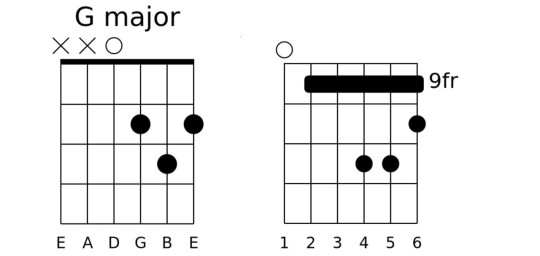
SVGuitar: Create SVG-Based Guitar Chord Charts — Very flexible and customizable and you can have a hand-drawn effect as well.
Raphael Voellmy
🗓 Upcoming Online Events
JS Nation (June 18-19) — This free two-day remote conference features over 25 speakers, including Jen Looper, Max Stoiber, John Papa and others.
OpenJS World (June 23-24) — Speakers at this 'virtual experience' include Nicole Sullivan, Prosper Otemuyiwa, Cassidy Williams and more.
CascadiaJS 2020 (September 1-2) — This upcoming online conference is set to take place in September.
by via JavaScript Weekly https://ift.tt/2Yu0uCP
0 notes
Link
Frequently asked questions of programming.
• Should I learn Python or JavaScript? • Data Science vs Web Development vs App Development, which one should I choose? • Why should I learn Web Development when there are popular Web Developing tools like Wix & WordPress? • All these points made me confused 😕 about what should I do?
So before starting with the questions Here's something about who I am and What makes me qualified to answer such questions? I'm a gradiot (an idiot who did his graduation and who has wasted money and time getting zero skills from college while there's an actual opportunity to learn everything online for free). Yes, I am a CS graduate. I have a great desire to make things, you might know the feeling of IT'S ALIVE if you have developed anything. During my college years I came across multiple technologies from Arduino to Raspberry pi, from PHP to JavaScript, Python, flutter you name it. I tried to learn and understand various technologies not due to college curriculum, but due to my desire to learn more and google 😎. Throughout my journey I encountered many questions and here are some of the questions I think will help you guys. Hope You'll like it.
Should I learn Python or JavaScript?
Before I start with why Python🐍 or JavaScript⚡. Let's talk about programming in general. Programming is a way of thinking and implementing the logic you create in a language that machines understand. Now there are styles or you can say structures of programming aka programming paradigms like Object-oriented programming (OOPs), Functional programming, procedural programming, etc. As a developer, you should at least know one of these paradigms. The more paradigms you know the broader choices you'll have for creating efficient and flexible code.

Back to the topic, Python and JavaScript both support OOPs and functional programming along with other paradigms. JavaScript is considered as the king of web programming that is used to create highly functional and dynamic websites. It has a vast ecosystem of libraries and frameworks to choose from like ReactJS, Angular, and Vue for front-end and NodeJS for the backend. You can also create native Apps for phones using React Native in JavaScript. So, with JavaScript, you can develop full-fledged websites as well as mobile applications. Whereas, Python is Best-suited programming language for Machine learning and data science. It has multiple Libraries like Keras, TensorFlow, Scikit-learn, etc. Along with that, Python is easy to use and has large community support. You can also create websites in python using frameworks like Django and Flask. You can also create apps in python as well using Tkinter, kiwi, etc. Both languages have powerful rounding development.
TL;DR Here is my perspective on this topic. As a developer, everyone must know basic web development since Machine learning and Data Science is a service-based skill While Web and App Development is a product-based skill. Hence, Data Science and Machine learning people are called engineers and not developers. Notice the very subtle difference between an engineer and a developer. Also, you know Mark Zuckerberg, Elon Musk, well they started with web dev and created their products. Ask yourself what you want, define your goals, and then choose wisely and always bet on JavaScript.
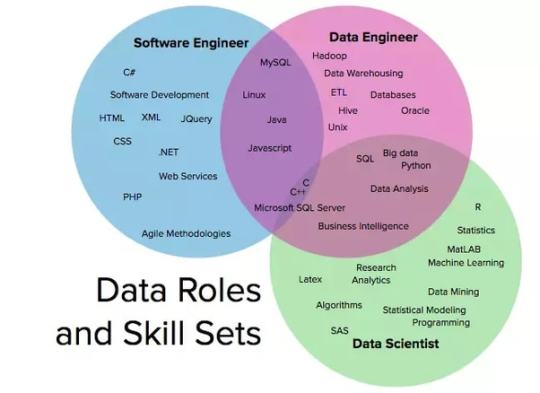
Data Science vs Web Development vs App Development Which one should I choose?
If you are reading this, you might be knowing very well the pay of a Data Science and ML engineers as compared to a Web Developer or an App Developer. All this huge burst about AI is the future and might very well draw you towards thinking that even I should learn Data Science for a huge package and a job opportunity. Here's the ugly truth, it's hard to get a job in Data Science since companies will prefer a person having the Domain knowledge and usually majoring in Mathematics and statistics, you should at least have Masters or Ph.D. for getting a job in this field. For Example- A fintech company will choose a CFA or Finance major rather than a CS engineer and teach them Data Science since python is easy and it's the efficiency that counts. So, the person with finance knowledge is well suited for the job. However, As I said It's hard to get a job, not impossible. Some CS grads have got into data science and are earning handful. All you need to learn is python and some libraries and mathematics. Now, As I said before, data science is a service-based skill you are not technically a developer you're an engineer who is figuring out solutions for a given problem. On the other hand, being a web or app developer means developing products. You can create applications and websites and release them to earn using ad revenue, selling them, or even creating and maintain them for companies that way you don't have to rely on companies to give your services. I suggest you to first, learn web development and then Data Science while earning through your web dev skills. That way you will have a decent skill set, portfolio, and a budget to start experimenting into the world of machine learning where processing power is everything.
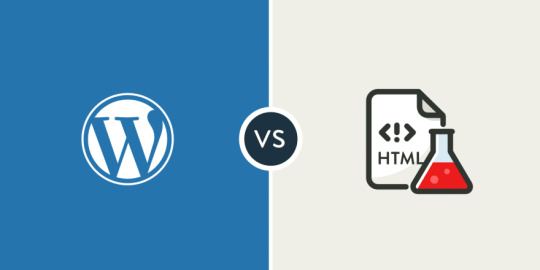
Why should I learn Web Development when there is a popular Web Developing tool like Wix & WordPress?
WordPress and Wix are popular content management systems. They are best for creating small websites and blogs. Yes, they made it easy for anyone to create websites but that doesn't mean web developers' jobs are gone. You can't create Amazon, Netflix, Twitter, and large fully functional websites using them. So, if you are trying to be a low-level web developer, you can pretty much say goodbye to developing websites. You can google top trending tech skills in demand and you will find AngularJS, ReactJS, NodeJS developers in demand. Not only websites but you can also create native applications for android and iOS using React-native and games using ThreeJS a JavaScript library. Possibilities are endless, all you have to do is START. I'll suggest you start with MERN stack just my personal opinion but you can research and pick whichever stack you like.
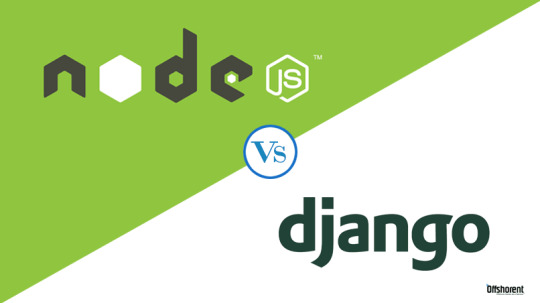
Is NodeJS better than Django?
Before comparing let's talk about what is NodeJS and Django. Node JS is a JavaScript runtime taken out of the client-side browser environment which uses OS binding for I/O, and Django is a Python framework. So comparing both is like comparing apples with oranges. Though let's have these points clear. When It comes to performance, Yes. NodeJS is faster than Django or in general python since it's written in C++ and is a JS runtime. You ask why? because JavaScript is faster than python because it works on an asynchronous non-blocking object model. When It comes to scalability, No. Django or python, in general, is highly scalable as the caching of applications is quite easy. Django is a high-level Python Web framework that encourages rapid development and clean, pragmatic design. With the introduction of npm which stands for the Node Package Management system, the open-source community has been boomed towards NodeJS since managing packages and dependencies has never been that easy. Also, npm is far better than pip when it comes to package management, you can research about it. Here are some of the big fishes and the backend tech they preferred for their development. Uber, Twitter, eBay, Netflix, Duckduckgo, PayPal, LinkedIn, Trello, Mozilla, GoDaddy are some big names using Node JS as their backend technology. Pinterest, Instagram, Eventbrite, Sentry, Zapier, Dropbox, Spotify, YouTube are also some big names using Django as their backend technology. Notice the trend here, Uber, Twitter, and Netflix are some of the applications that priorities performance whereas Pinterest, Instagram, YouTube requires a lot of space and thus scalability is their priority. So, the choice is upon you what you want scalability or performance.
All these points made me confused 😕 about what should I do?
First, ask yourself what do you enjoy doing. Do you like to create games, apps, websites? What intrigues you? What sparks your curiosity? I have listed some of the questions depending upon the choices you make.
• GAME Development – If you want to get into the game development industry, you will have to learn C# or C++ for hardcore game development. You can create web games using ThreeJS or any other library but you won't be exactly a game developer.
• App Development – You can create an application using JAVA for android or Swift for iOS. Further, you can use React-native or Flutter for creating apps that would run on both android and iOS. If you want web apps, you can use Ionic as well.
• Web Development – There are many stacks (a set of technologies that suits well with each other) you could choose to learn like MEAN stack, MERN stack, LAMP stack, etc. You can create a website from WordPress or Wix as well. Develop an interactive portfolio for yourself with the stack you find interesting.
• Data Science, ML, AI – Start with python and take courses on data science, mathematics, machine learning, from popular websites like Udemy or LinkedIn. Start competing on Kaggle and maintain your Kaggle profile. Second, do yourself a favor and start learning algorithms and data structures in the language that fits your answer to the above question. Third, Start applying for internships with some projects and try to make an exemplary portfolio. Maintain your GitHub, LeetCode or HackerRank or any other profiles which you can include on your resume.
I hope this might help you; I tried my best to answer some of the questions that I've faced throughout my journey as a gradiot. If you feel that I'm missing something or something is wrong please feel free to correct me in the comment section. Thank you for your valuable time.
0 notes
Photo

Angular JS vs. Node JS vs. React JS: Which Would Be Best? ☞ http://bit.ly/2oJOOxY #angularjs #javascript
0 notes
Photo

Angular JS vs. Node JS vs. React JS: Which Would Be Best? ☞ http://bit.ly/2oJOOxY #angularjs #javascript
0 notes
Link
One of the most important questions for any business willing to develop an application is, “which front-end technology (client-side) should we choose?” With so many options for JavaScript frameworks available, your app development team needs to be cautious about their choice. This article will examine the positives and negatives of React, Angular, and Vue and situations in which each is optimal to use. What Is Angular? Angular is an open source, frontend web app framework by Google that has a Model-View-Controller (MVC) architecture and makes development, maintenance, and testing easier for developers. It’s great for building highly active and interactive web applications, but it is most popular for Single page applications. Latest Angular release cycle Source You may also like: Everything React: Tutorials for Beginners and Experts Alike. What Is React? Introduced by Facebook, React is an open source JavaScript library for building interactive, stateful, and reusable user interfaces (UI). It is good for rendering complex UI with high performances. It also works with the basic fundamental of virtual Document Object Model (DOM) to offer a highly stable web application. React Native What Is Vue? Vue is a progressive JavaScript framework for building user interfaces. Vue is designed from the ground up to be incrementally adoptable. It comes with various optional tools for building user interfaces. Vue has a high capability of backing sophisticated Single-Page Applications when used in combination with modern tooling and supporting libraries. Popularity Well, if you see the analytics snapshot of Google trends, Angular was very popular until 2016, but from 2017 on, searches for React are steadily growing. Popularity by Google search traffic The Stackoverflow also shows the popularity of tags. Between “AngularJS,” “ReactJS,” and “VueJS” and popularity of React is clear. Popularity by Stack Overflow searches With every new update, React, Angular, and Vue come with new features that further offer reliability and stability to the web apps. Difference Between Angular, React, and Vue Differences between Angular, React, and Vue Benefits of AngularJS Web applications built on Angular run in any browser environment, regardless of the platform. Two-way, or bidirectional data binding, ensure that data change in the model will reflect in the view immediately, and when data in the view changes, the model is also updated. Two-way data binding The pre-built material design components help in building a highly interactive and easily navigable UI for your mobile/web app. The Angular Command Line Interface ensures easy updates of components from third-party which reduces the time to create apps and deploy the same. Benefits of React Virtual DOM helps React developers an easily render any changes in the application without affecting the other parts of the interface. React allows users to reuse components. This makes app development easier and more efficient. React uses Redux, which simplifies storing and managing component states in large applications. Unidirectional data binding makes code stable and supports future development as the data flow is directed towards one direction. Benefits of Vue One of the most significant benefits of Vue is its small size. It comes with detailed documentation. It allows developers to write a template in an HTML file, JavaScript file, and pure JavaScript file, using virtual Node. Its MVVM architecture makes it quite easy to handle HTML blocks. Finding the Right Framework for You Performance Performance is the most important aspect of a frontend application. HTML requires much attention from the developers. Both React and Angular take completely different approaches to update HTML that in turn affect the performance of an application. However, considering the direct changes in DOM in the browser, Angular is best suited for Single-page applications, where the content is updated occasionally. On the other hand, React can be selected for applications of any size, which needs content update regularly (for example Instagram). While talking about Vue.js performance, its core library is focused on the view layer only and is easy to pick up & integrate with other libraries or existing applications. Vue.js also comes with virtual DOM delivering high performance and memory allocation. However, these three frameworks are comparatively faster than other JavaScript frameworks. Speed of Development Though modification is easy with both React and Angular, the speed of your application depends on the number of libraries with the functionalities that are available to the developers. React’s architecture is easier to scale than Angular, but developing a web app in Angular is faster than React. For rendering a relatively complex UI with some user interaction, all three frameworks are a great choice. But, if you are looking for something that you can add to your app instantly, Vue is an excellent choice. Vue makes it easy to go from prototype to product. Application Size Angular holds all the necessary parts of a Minimum Viable Product to produce a fully functional Single-page application. If you want to regulate the size of your app and keep it small and compact, then Angular is the best choice. On the other hand, React is a great choice for applications that you desire to expand in the future across multiple operating systems. Vue's core library is created to be focused and flexible. As a result, Vue is great for applications of any size: single-file components, highly modular component interface, platform options with Vue CLI3, etc. So, if you are using it for a moderately complex single page or larger-scale app that includes navigation between multiple pages, it will work well. Some popular examples of these JS frameworks Conclusion While React gives you flexibility and simplicity, Angular is a comprehensive framework. But that doesn’t help a lot when developers don’t need most of the features that Angular provides. Due to Reactjs’s implementation with a virtual DOM, it guarantees better performances than Angular. Being a progressive framework, Vue can be combined into an existing project. It comes with a vast set of tools and companion libraries that allow the framework to respond to the complex needs of enterprise-grade applications. Also, with Vue CLI 3 and Vue UI, it is great for quickly delivering MVPs. Vue is also a cost-effective solution for small and medium applications. Further Reading
0 notes
Photo

Angular JS vs. Node JS vs. React JS: Which Would Be Best? ☞ http://bit.ly/2oJOOxY #angularjs #javascript
0 notes
Text
Drupal 8 Is Not A CMS, It’s CMF

https://solaceinfotech.com/blog/drupal-8-is-not-a-cms-its-cmf/
Drupal is a scalable, open platform for web content and digital experiences management. It is a free platform written in PHP and distributed under the General Public License. It provides profound capabilities and endless flexibility on the web. Initially, we were also installing and configuring Drupal, creating content types, menus, views, taxonomy etc. to create not just beautiful but secured and performing websites.
When JS framework and decoupling came to the market, we coordinated AngularJS with Drupal to create more user-friendly websites. This blog is about – Drupal is CMS or CMF? To know this, first of all see What is CMS and What is CMF?
CMS-
A content management system (CMS) is a computer program which allows publishing, editing and modifying content on a web site as well as maintenance from a central page. A content management system, should be ready to go right out of the limit- something that non-developer can easily setup to use. The main purpose of the CMS is to manage the content( For eg., WordPress).
CMF-
A content management framework (CMF) is a system that facilitates the use of reusable components or customized software for managing web content. A CMF is more like a box of Legos. It could be used to make something very simple, or in the hands of an expert, it could be used to make something VERY complicated.
One of the popular views of a CMF is that, it has to be based on MVC(Model, Views, Controller) architecture. For eg., CodeIgniter, CakePHP.
CMS vs CMF-
In about 2001 Dries Buytaert released Drupal. It began similarly as a simple forum software. However, thanks to the invention of the Node, it quickly evolved from there.
Until Version 4.6, Drupal was still a Node management system or a CMS.
But then something changed…
In Version 4.7, Drupal now had the ability of two awesome Modules called CCK and Views. This was the real turning point for Drupal. This was a point, when it stopped being a CMS and starting to become a true Framework.
This is when all these pre-defined Nodes started being replaced with “text-fields” and “date-fields” and “image-fields“. No longer were we confined to using a pre-built solution, we were instead encouraged to build our own. From few years with Drupal 8, you can see that transformation is almost complete.
Never again will you discover Recipe Modules for download. The expectation for Drupal these days is that you will build your own content.
Compatible modules or functionality to call it a CMF-
1. Exchange of relevant data-
It is helpful to reuse the data on numerous applications, after feeding it once on a single application. Whereas the creation of content is a tedious, time-consuming and costly task. Based on the requirement, whole or sub-set of data can be exchanged within numerous applications. One of the most important benefits of Drupal for exchanging the data is Feeds. These feeds are used to import data, while Views with JSON or XML format output helps to export or provide the required data to third-party applications. Out of the box modules that integrate with various Geolocation tools, Payment Services, Social Networks, CRM, ERP and many other open standards are also available in Drupal.
2. Third party authentication-
For any application, the users’ journey begins with sign-up and login so that users can access the authorized content.
Nowadays, where everything is available just on click, sign-up and login should be quick and easy. So, now almost each application provides a social media login or SSO so that their users can access the authorized content or sub-domain or sub-sites. This authentication process must be secure while being quick. Various authentication modules are available on Drupal like Google authentication, Social Media sign-ins etc. Apart from this, customization can also be done using Authentication API, RESTful web services API for 3rd party application sign-ins.
3. Subscription or user type based Access control-
Content authoring and publishing requires a workflow and necessary permission to access the draft or review content. An access control of data also vary based on subscription for the end user or any third-party consumer. Roles and permissions gives access control which is more than enough, however, the Workflow and Rules module can be configured for particular access requirements. Higher customization can be done if required as RESTful web services API are part of Drupal core.
4. Having large numbers of users-
If the time required to produce and give the result to the end-user is minimum, then the framework will engage more users. Also caching the result or data is the best part to solve this purpose.
Drupal provides multiple caching for blocks, pages etc. and also it is quite intelligent. Drupal has a benefit of setting the cache timer which require special access permission to the end user. For eg., About us page or most popular articles block can be cached from a few hours to days. Whereas, latest Tweets or Facebook posts to be cached only for 15 Mins to a few hours only. This can be increased using Memcache, Varnish, APC or PHP 7 opcode cache.
5. Integration with JS Framework like Angular, React-
Drupal provides flexibility to apply animation to represent data, also have desired look and feel for the same block or change and update it whenever required.
JS framework can be integrated by using libraries and tweaking the template file. However, to make it easier now Drupal is looking to adopt React.This implies the application can use the best of both worlds. Where Drupal will provide the user, content management, and workflow. Also, by using feed, REST APIs or views (as mentioned above) the representation of data can be beautify using JS frameworks.
6. Quick turnaround for production setup-
Out of the limitations, distributions are available on Drupal to develop basic commerce or social media sites. Due to this, developing a basic commerce site would only take a few days.
Configuration Management System, Distribution (installation profiles) help for a quick turnaround along with the features, hook_install, and devel module to create dummy data (If required). As a result, this helps in creating multiple instances of the same site.
7. E2E and automated testing-
Automation also helps in test coverage, data-driven testing, and performing different types of testing such as Functional, Regression, Smoke, API, etc. – both, efficiently and effectively.
This is possible because of simpletest, an integral part of Drupal that requires the developer to write test files at the time of module writing so that any changes in the modules can be verified then and there; and is largely used for Behavior Driven Development. Thereby, saving a lot of time and cost.
Conclusion-
Considering these benefits Drupal provides, it is more than a CMS, it is a CMF.
0 notes
Link
#reactjs development company#Angular JS#AngularJS vs React JS vs Node JS#Full Stack Developer React JS
0 notes
Link
#AngularJS vs ReactJS vs NodeJS#Angular vs React vs Node - which is the best?#Comparison of JS Frameworks#differences between React.js#differences between React.js Node.js and AngularJS#ReactJS vs Angular Comparison
0 notes
Text
What is the MEAN stack? JavaScript web applications
The MEAN stack is a software stack—that is, a set of the technology layers that make up a modern application—that’s built entirely in JavaScript. MEAN represents the arrival of JavaScript as a “full-stack development” language, running everything in an application from front end to back end. Each of the initials in MEAN stands for a component in the stack:
MongoDB: A database server that is queried using JSON (JavaScript Object Notation) and that stores data structures in a binary JSON format
Express: A server-side JavaScript framework
Angular: A client-side JavaScript framework
Node.js: A JavaScript runtime
A big part of MEAN’s appeal is the consistency that comes from the fact that it’s JavaScript through and through. Life is simpler for developers because every component of the application—from the objects in the database to the client-side code—is written in the same language.
This consistency stands in contrast to the hodgepodge of LAMP, the longtime staple of web application developers. Like MEAN, LAMP is an acronym for the components used in the stack—Linux, the Apache HTTP Server, MySQL, and either PHP, Perl, or Python. Each piece of the stack has little in common with any other piece.
This isn’t to say the LAMP stack is inferior. It’s still widely used, and each element in the stack still benefits from an active development community. But the conceptual consistency that MEAN provides is a boon. If you use the same language, and many of the same language concepts, at all levels of the stack, it becomes easier for a developer to master the whole stack at once.
Most MEAN stacks feature all four of the components—the database, the front end, the back end, and the execution engine. This doesn’t mean the stack consists of only these elements, but they form the core.
MongoDB
Like other NoSQL database systems, MongoDB uses a schema-less design. Data is stored and retrieved as JSON-formatted documents, which can have any number of nested fields. This flexibility makes MongoDB well-suited to rapid application development when dealing with fast-changing requirements.
Using MongoDB comes with a number of caveats. For one, MongoDB has a reputation for being insecure by default. If you deploy it in a production environment, you must take steps to secure it. And for developers coming from relational databases, or even other NoSQL systems, you’ll need to spend some time getting to know MongoDB and how it works. InfoWorld’s Martin Heller dove deep into MongoDB 4 in InfoWorld’s review, where he talks about MongoDB internals, queries, and drawbacks.
As with any other database solution, you’ll need middleware of some kind to communicate between MongoDB and the JavaScript components. One common choice for the MEAN stack is Mongoose. Mongoose not only provides connectivity, but object modeling, app-side validation, and a number of other functions that you don’t want to be bothered with reinventing for each new project.
Express.js
Express is arguably the most widely used web application framework for Node.js. Express provides only a small set of essential features—it’s essentially a minimal, programmable web server—but can be extended via plug-ins. This no-frills design helps keep Express lightweight and performant.
Nothing says a MEAN app has to be served directly to users via Express, although that’s certainly a common scenario. An alternative architecture is to deploy another web server, like Nginx or Apache, in front of Express as a reverse proxy. This allows for functions like load balancing to be offloaded to a separate resource.
Because Express is deliberately minimal, it doesn’t have much conceptual overhead associated with it. The tutorials at Expressjs.com can take you from a quick overview of the basics to connecting databases and beyond.
Angular
Angular (formerly AngularJS) is used to build the front end for a MEAN application. Angular uses the browser’s JavaScript to format server-provided data in HTML templates, so that much of the work of rendering a web page can be offloaded to the client. Many single-page web apps are built using Angular on the front end.
One important caveat: Developers work with Angular by writing in TypeScript, a JavaScript-like typed language that compiles to JavaScript. For some people this is a violation of one of the cardinal concepts of the MEAN stack—that JavaScript is used everywhere and exclusively. However, TypeScript is a close cousin to JavaScript, so the transition between the two isn’t as jarring as it might be with other languages.
For a deep dive into Angular, InfoWorld’s Martin Heller has you covered. In his Angular tutorial he’ll walk you through the creation of a modern, Angular web app.
Node.js
Last, but hardly least, there’s Node.js—the JavaScript runtime that powers the server side of the MEAN web application. Node is based on Google’s V8 JavaScript engine, the same JavaScript engine that runs in the Chrome web browser. Node is cross-platform, runs on both servers and clients, and has certain performance advantages over traditional web servers such as Apache.
Node.js takes a different approach to serving web requests than traditional web servers. In the traditional approach, the server spawns a new thread of execution or even forks a new process to handle the request. Spawning threads is more efficient than forking processes, but both involve a good deal of overhead. A large number of threads can cause a heavily loaded system to spend precious cycles on thread scheduling and context switching, adding latency and imposing limits on scalability and throughput.
Node.js is far more efficient. Node runs a single-threaded event loop registered with the system to handle connections, and each new connection causes a JavaScript callback function to fire. The callback function can handle requests with non-blocking I/O calls and, if necessary, can spawn threads from a pool to execute blocking or CPU-intensive operations and to load-balance across CPU cores.
Node.js requires less memory to handle more connections than most competitive architectures that scale with threads—including Apache HTTP Server, ASP.NET, Ruby on Rails, and Java application servers. Thus, Node has become an extremely popular choice for building web servers, REST APIs, and real-time applications like chat apps and games. If there is one component that defines the MEAN stack, it’s Node.js.
Advantages and benefits of the MEAN stack
These four components working in tandem aren’t the solution to every problem, but they’ve definitely found a niche in contemporary development. IBM breaks down the areas where the MEAN stack fits the bill. Because it’s scalable and can handle a large number of users simultaneously, the MEAN stack is a particularly good choice for cloud-native apps. The Angular front end is also a great choice for single-page applications. Examples include:
Expense-tracking apps
News aggregation sites
Mapping and location apps
MEAN vs. MERN
The acronym “MERN” is sometimes used to describe MEAN stacks that use React.js in place of Angular. React is a framework, not a full-fledged library like Angular, and there are pluses and minuses to swapping React into a JavaScript-based stack. In brief, React is easier to learn, and most developers can write and test React code faster than they can write and test a full-fledged Angular app. React also produces better mobile front ends. On the other hand, Angular code is more stable, cleaner, and performant. In general, Angular is the choice for enterprise-class development.
But the very fact that this choice is available to you demonstrates that MEAN isn’t a limited straitjacket for developers. Not only can you swap in different components for one of the canonical four layers; you can add complementary components as well. For example, caching systems like Redis or Memcached could be used within Express to speed up responses to requests.
MEAN stack developers
Having the skills to be a MEAN stack developer basically entails becoming a full-stack developer, with a focus on the particular set of JavaScript tools we’ve discussed here. However, the MEAN stack’s popularity means that many job ads will be aimed at full-stack devs with MEAN-specific skills. Guru99 breaks down the prerequisites for snagging one of these jobs. Beyond familiarity with the basic MEAN stack components, a MEAN stack developer should have a good understanding of:
Front-end and back-end processes
HTML and CSS
Programming templates and architecture design guidelines
Web development, continuous integration, and cloud technologies
Database architecture
The software development lifecycle (SDLC) and what it’s like developing in an agile environment[Source]-https://www.infoworld.com/article/3319786/what-is-the-mean-stack-javascript-web-applications.html
62 Hours Mean Stack Training includes MongoDB, JavaScript, A62 angularJS Training, MongoDB, Node JS and live Project Development. Demo Mean Stack Training available.
0 notes
Text
Difference Between React JS vs Angular JS
The primary difference between AngularJS and ReactJS lies in the state of its management. AngularJS has data binding bundled in by default, whereas React is generally augmented by Redux to give unidirectional data flow and work with immutable data.
Prompt rendering is among the best features of React that gives a significant edge over Angular. The core difference between React JS and Angular JS. That React is JS-centric, while ng2 remains HTML-centric. JavaScript is far more robust than HTML, that makes React far more simple, focused and consistent. It's very common knowledge in the JavaScript community that Angular1/Angular2 has much larger API to learn than ReactJS +FLUX (combined). In Angular, in general, the learning curve is much steeper so that means that being efficient in that area of expertise is much harder than in React. Because ReactJS helps to prevent updating of DOM, it means that the apps will be faster and deliver better UX. ReactJS was designed to help improve the total rendered pages from the website server. Besides, it utilizes nodes to render on the client-side. React vs. Angular: Which one is easier. Angular is a full-featured MVC framework, developed and maintained by Google whereas React is an open-source JS library which is developed and maintained by Facebook. The toolchain in React is high as compared to Angular where it is low.
#react#angular#web development company#react js#react js framework#reactjs development services#best web development company#angular js
0 notes
Photo
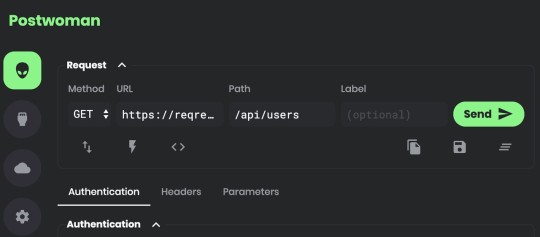
How the top 6 million sites are using JavaScript
#464 — November 22, 2019
Read on the Web
JavaScript Weekly
Postwoman: An API Request Builder and Tester — A free alternative to Postman, a popular app for debugging and testing HTTP APIs. Postwoman works in the browser and supports HTTP and WebSocket requests as well as GraphQL. Insomnia is a similar tool if you want to run something as a desktop app.
Liyas Thomas
The State of JavaScript on the Web by the HTTP Archive — The HTTP Archive has released an annual ‘state of the Web’ report focused on data collected from six million sites. There are numerous findings here, including how much JavaScript the Web uses, how long it takes browsers to parse that JavaScript, and what frameworks and libraries are most popularly used.
Houssein Djirdeh
Get Best in Class Error Reporting for Your JavaScript Apps — Time is money. Software bugs waste both. Save time with Bugsnag. Automatically detect and diagnose errors impacting your users. Get comprehensive diagnostic reports, know immediately which errors are worth fixing, and debug in minutes. Try it free.
Bugsnag sponsor
The Differences Between the Same App Created in React and Svelte — Several issues ago we linked to Sunil’s article comparing the same app written in React and Vue and now he’s back with a side by side comparison of some of the differences between an app built in React and Svelte, an increasingly popular build-time framework.
Sunil Sandhu
Node Gains Enabled-By-Default Support for ECMAScript Modules — Node.js 13.2.0 came out this week with both an upgrade to V8 and unflagged support for using ES modules. There are some rules to using them, and you might find this V8 blog entry on JavaScript modules worth revisiting to get a feel for what’s involved. Time to play!
Node.js Foundation
jQuery Core Migrating from AMD Modules to ES Modules — Before you say jQuery isn’t relevant, the HTTP Archive has revealed that it’s being used on ~85% of around 6 million sites.
jQuery
Pika Opens Its 'Write Once, Run Natively Everywhere' JavaScript Registry for Early Access — Rather than authors being responsible for formatting and configuring packages, the registry takes care of it. You write the code, they, in theory, do the rest (including creating TypeScript type declarations). Sadly it’s behind an email wall for now, so watch this space.
Pika
⚡️ Quick Releases
video.js 7.7 — Cross-browser video player.
Svelte 3.15.0 — Compile-time app framework.
Leaflet 1.6 — Mobile-friendly interactive maps.
AngularJS 1.7.9 —An update to the original Angular.
CanJS 6.0 — Data-driven app framework.
Ember 3.14
💻 Jobs
Full Stack Engineer — Expensify seeks a self-driven individual passionate about making code effective, with an understanding of algorithms and design patterns.
Expensify
Senior Web Frontend Engineer (CA, IL or NC) — Design what machine learning "looks" like to improve the manufacturing of millions of things. We value great tools like fast builds, simple deploys, & branch environments.
Instrumental
Find a Job Through Vettery — Make a profile, name your salary, and connect with hiring managers from top employers. Vettery is completely free for job seekers.
Vettery
📘 Articles & Tutorials
Getting Started with an Express.js and ES6+ JavaScript Stack — With typical Smashing Magazine quality, this is a thorough beginner-level walkthrough, this time covering how to get started with Node in building a web app backed by a MongoDB database. Definitely for beginners though.
Jamie Corkhill
Techniques for Instantiating Classes — Dr. Axel walks through several approaches for creating instances of classes.
Dr. Axel Rauschmayer
How To Build a Sales Dashboard with React — Improve your data visualization with JavaScript UI controls. Build interactive dashboards quickly and easily.
Wijmo by GrapeCity sponsor
▶ We Should Rebrand JavaScript. Yep? Nope? — A podcast where two pairs of JavaScript developers debate an idea that was recently floated.. should we rebrand JavaScript?
JS Party podcast
Compile-Time Immutability in TypeScript — How to achieve compile-time immutability in TypeScript with const assertions and recursive types.
James Wright
Having Fun with ES6 Proxies — Proxies aren’t going to be useful in day to day programming for most JavaScript developers, but they open up some interesting opportunities if you want more control over how objects behave and are worth understanding.
Maciej Cieślar
▶ How to Build a Budget Calculator App with Angular — A 2 hour video that walks through the entire process of building an Angular app. The gentle pace is well aimed at those new to Angular or the tooling involved.
Devstackr
Composing Angular Components with TypeScript Mixins
Giancarlo Buomprisco
Hey Node Helps You Think, Prototype, and Solve in Node.js — Transforming data, package.json, the module system and more. Bite-size, info-packed tutorials with videos and use cases.
Hey Node by Osio Labs sponsor
Cropping Images to a Specific Aspect Ratio with JavaScript — How to use the HTML canvas API and some basic math to build a tiny crop helper function, making it easy to quickly crop images in various aspect ratios.
Rik Schennink
🔧 Code & Tools
EasyDB: A 'One-Click' Server-Free Database — A quick way to provision a temporary database (that’s basically a key/value store) and use it from JavaScript. Ideal for hackathons or quick once-off scripts, perhaps.
Jake and Tyson
Nodemon: Automatically Restart a Node App When Files Are Changed — A development-time tool to monitor for any changes in your app and automatically restart the server. v2.0 has just been released with CPU and memory use improvements and far fewer��dependencies.
Remy Sharp
GraphQuill: Real-Time GraphQL API Exploration in VS Code — A way to test GraphQL API endpoints from within VS Code so you don’t have to keep jumping between multiple tools.
OSLabs Beta
Open Realtime Data - A User’s Guide with Links to a Free Streaming Platform
Ably sponsor
Lambda API: A Lightweight Web Framework for Serverless Apps — A stripped down framework that takes an Express-esque approach to putting together serverless JavaScript apps to run on AWS Lambda behind API Gateway.
Jeremy Daly
ScrollTrigger: Let Your Page React to Scroll Changes — Triggers classes based on the current scroll position. So, for example, when an element enters the viewport you can fade it in.
Erik Terwan
Siriwave: The Apple Siri 'Waveform' Replicated in a JS Library
Flavio Maria De Stefano
by via JavaScript Weekly https://ift.tt/2XI7YS2
0 notes
Link
What is React?
React is a front-end library developed by Facebook. It is used for handling the view layer for the web and mobile apps. ReactJS allows us to create reusable UI components. Unlike AngularJS, React is not a framework, rather it is an open-source library created by FACEBOOK. React allows developers to create/compose large web applications with complex UIs from small and isolated pieces of code called “components” which can change data, without reloading the page.
Pre-requisites :
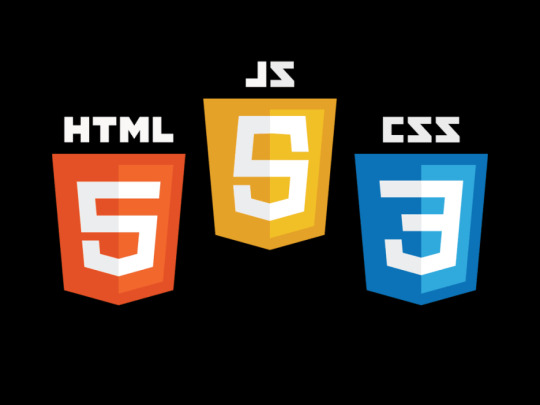
If you want to work with ReactJS, you need to have a solid knowledge of JavaScript, HTML5, and CSS. Even though ReactJS doesn't use HTML, the JSX is similar so your HTML knowledge will be very helpful.
Why ReactJS?
In traditional web application programming, for even a small change in the webpage, the whole page is reloaded. This makes the web pages slower than they should be.
React Features :
JSX: JSX is JavaScript syntax extension. JSX is simple JavaScript which allows HTML quoting and uses these HTML tag syntax to render subcomponents. It isn't necessary to use JSX in React development, but but JSX makes React a lot more elegant.
Components: React is all about components. You need to think of everything as a component. Components let you split the UI into independent, reusable pieces.
Uni-Directional data flow and Flux: React implements one-way data flow which makes it easy to reason about your app. Flux is a pattern that helps keeping your data unidirectional.
Advantages of using React :
It uses virtual DOM which is a JavaScript object. This will improve apps performance since JavaScript virtual DOM is faster than the regular DOM.
It can be used on the client and server-side as well as with other frameworks.
Components and data patterns improve readability, which helps to maintain larger apps.
Create React App :
Before moving further, let’s set up our code. Make sure you have the latest LTS version of Node and npm installed. We’ll use React CLI to help us set up projects easily and run our app using a built-in development server. Create React App comes prefigured with a webpack, along with a plug-in system to run tools like Babel. First, we need to install React CLI. Head over to your terminal then type:

npm install react.cli -g command will install React CLI globally on your system, and create-react-app sets up a new React project. A project named first-app with some files inside it gets created at the required destination. npm start runs the project in a development server on localhost:3000.
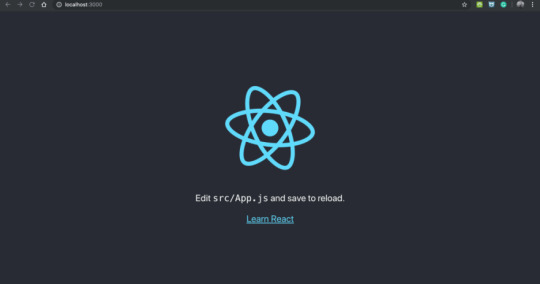
The React project file structure should look something like:
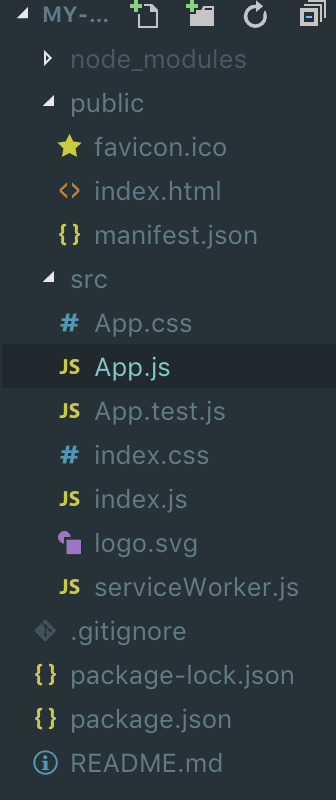
All the JavaScript we create will go into the src folder. The React logo on the screen is rendered through App.js where we are outputting the logo.svg. Let’s get rid of these files. Delete App.css (this is just a local CSS file for App.js), App.test.js (you won’t need it for quite a few days), and logo.svg. Now lets head over to App.jsand type the below code into it.

Now if you go back to the localhost:3000, you’ll see “Hello, React!”. We have the beginnings of a React app now.
What is JSX and Rendering in React?
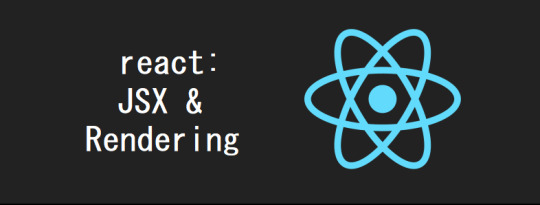
JSX :
React uses JSX for templating instead of regular JavaScript. It is not necessary to use it, however, the following are the advantages that come with it:
It is faster because it performs optimization while compiling code to JavaScript.
It is also type-safe and most of the errors can be caught during compilation.
It makes it easier and faster to write templates if you are familiar with HTML
The following code in App.js renders "Hello, World!!!" on the screen.

JavaScript expressions can be used inside JSX. We just need to wrap it with curly brackets {}. The following example will render 2.

Know more about JSX at JavaScript XML-JSX.
Rendering in React :
React element is the smallest renderable unit available in React. We can render such elements using the ReactDOM. React elements are different from DOM elements as React elements are simple javascript objects and are efficient to create. React elements are the building blocks of any React app and should not be confused with React components.
Elements are the smallest building blocks of React apps.
An element describes what you want to see on the screen.
Let’s say there is a "div" somewhere in your HTML file. Eg:

We call this a “root” DOM node because everything inside it will be managed by React DOM.
The following code displays “Hello, React” on the page.

Know more about Rendering Elements in React at JavaScript XML-JSX.
Components in React :
React is designed around the concept of reusable components. You define small components and you put them together to form bigger components.

Every application you will develop in React will be made up of pieces called components. Components make the task of building UIs much easier. You can see a UI broken down into multiple individual pieces called components and work on them independently and merge them all in a parent component which will be your final UI.
All components small or big are reusable, even across different projects.
The component name starts with a capital letter. This is required since we will be dealing with a mix of HTML elements and React elements. Lowercase names are reserved for HTML elements. In fact, go ahead and try to name the React component just “button” and see how ReactDOM will ignore the function and renders a regular empty HTML button.
Every component receives a list of attributes, just like HTML elements. In React, this list is called props. With a function component, you can name it anything though.
Components in React basically return a piece of JSX code which tells what should be rendered on the screen. In React we mainly have two types of components:

i) Functional Component or Stateless Component:
It is simple javascript functions that simply returns html UI
It is also called “stateless” components because they simply accept data and display them in some form that is they are mainly responsible for rendering UI.
It accept properties(props) in function and return html(JSX)
It gives solution without using state
There is no render method used in functional components.
These can be typically defined using arrow functions but can also be created with the regular function keyword.
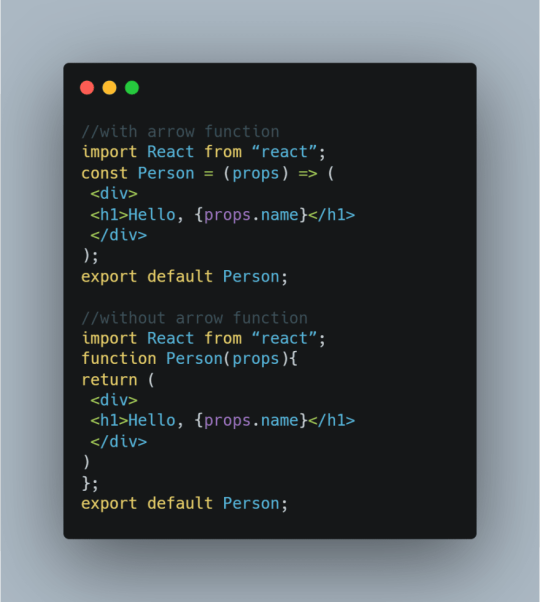
ii) Class Component or Stateful Component:
It is regular ES6 classes that extends component class form react library
Also known as “stateful” components because they implement logic and state.
It must have render() method returning html
It has complex UI Logic
You pass props(properties) to class components and access them with this.props
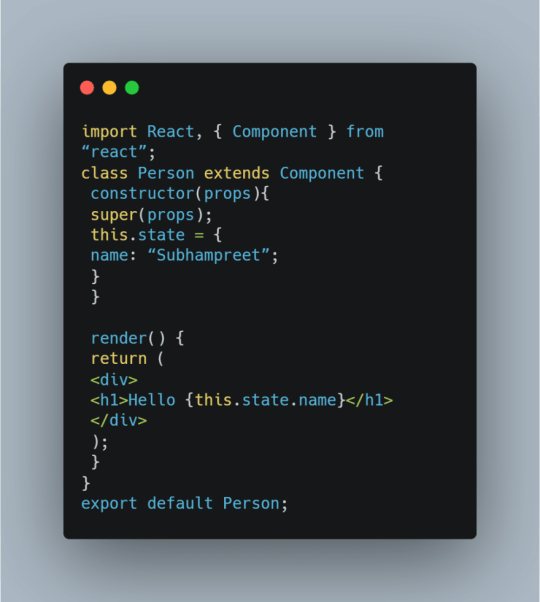
For now, keep in mind that we will use functional component only when we are sure that our component does not require to interact or work with any other component. That is, these components do not require data from other components however we can compose multiple functional components under a single functional component. We can also use class-based components for this purpose but it is not recommended as using class-based components without need will make your application in-efficient.
To render a component in React we can initialize an element with a user-defined component and pass this element as the first parameter to ReactDOM.render() or directly pass the component as the first argument to the ReactDOM.render() method.

Let us see step-wise what is happening in the above example:
We call the ReactDOM.render() as the first parameter.
React then calls the component Welcome, which returns Hello World! as a result.
Then the ReactDOM efficiently updates the DOM to match with the returned element and renders that element to the DOM element with id as “root”.
Know more about components and props at Components in React JS.
props and state in React JS:
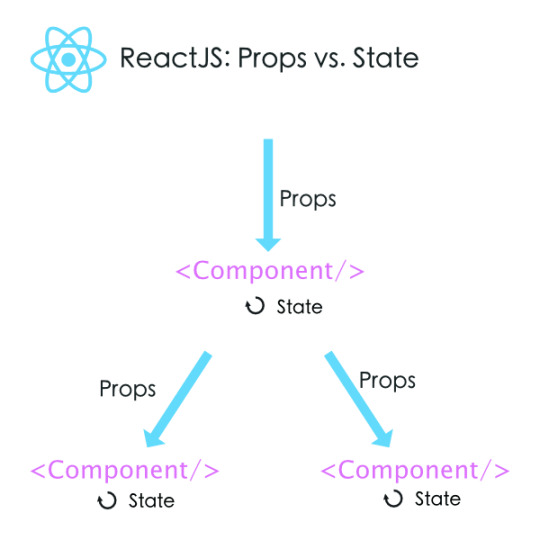
What are props?
Props are short for properties and they are used to pass data between React components. React’s data flow between components is uni-directional (from parent to child only).
How do you pass data with props?
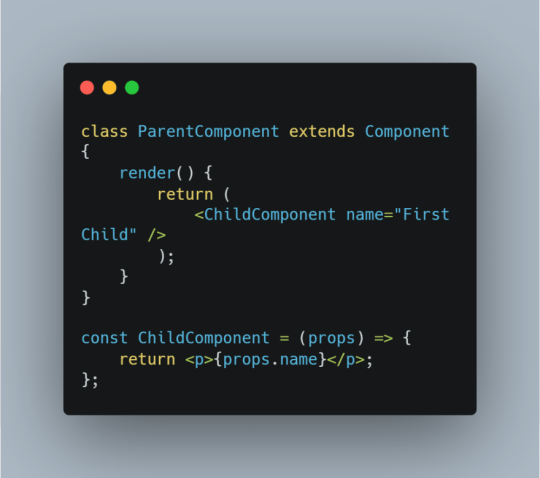
Firstly, we need to define/get some data from the parent component and assign it to a child component’s “prop” attribute.

“Name” is a defined prop here and contains text data. Then we can pass data with props like we’re giving an argument to a function:
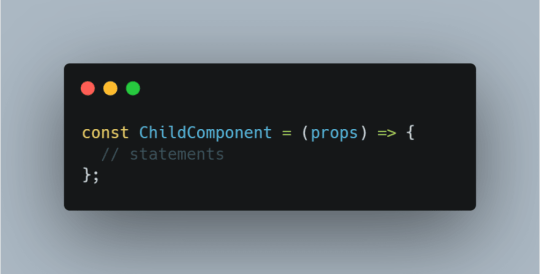
And finally, we use dot notation to access the prop data and render it:
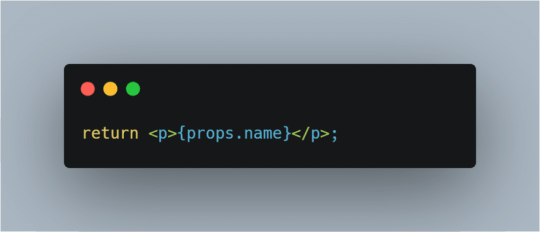
What is state?
React has another special built-in object called state, which allows components to create and manage their own data. So unlike props, components cannot pass data with state, but they can create and manage it internally.
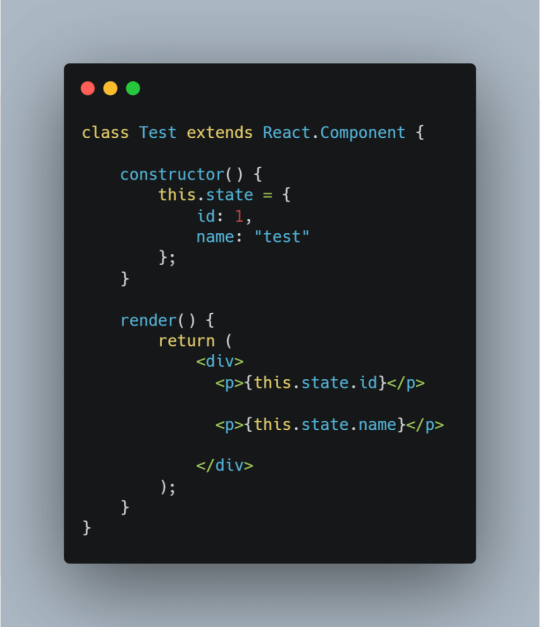
How do you update a component’s state?
State should not be modified directly, but it can be modified with a special method called setState( ).

What happens when state changes?
A change in the state happens based on user-input, triggering an event, and so on. Also, React components (with state) are rendered based on the data in the state. State holds the initial information.
So when state changes, React gets informed and immediately re-renders the DOM – not the whole DOM, but only the component with the updated state. This is one of the reasons why React is fast.
And how does React get notified? You guessed it: with setState( ). The setState( ) method triggers the re-rendering process for the updated parts. React gets informed, knows which part(s) to change, and does it quickly without re-rendering the whole DOM.
State shouldn’t be modified directly – the setState( ) should be used
State affects the performance of your app, and therefore it shouldn’t be used unnecessarily
props vs state
Components receive data from outside with props, whereas they can create and manage their own data with state
Props are used to pass data, whereas state is for managing data
Data from props is read-only, and cannot be modified by a component that is receiving it from outside
State data can be modified by its own component, but is private (cannot be accessed from outside)
Props can only be passed from parent component to child (unidirectional flow)
Modifying state should happen with the setState( ) method
Know more about component state at Components state in React JS.
Lifecycle of Components:
React component lifecycle executes in three different intervals/phases. These three phases are Mounting, Updating, and Unmounting. Within these phases, there are methods called Lifecycle hooks that happen in a particular order.

A React Component can go through four stages of its life as follows.
Initialization: This is the stage where the component is constructed with the given Props and default state. This is done in the constructor of a Component Class.
Mounting: Mounting is the stage of rendering the JSX returned by the render method itself.
Updating: Updating is the stage when the state of a component is updated and the application is repainted.
Unmounting: As the name suggests Unmounting is the final step of the component lifecycle where the component is removed from the page.
Mounting or Initial phase
constructor( )
componentWillMount( )
render( )
componentDidMount( )
Updating phase
componentWillReceiveProps( )
shouldComponentUpdate( )
componentWillUpdate( )
render( )
componentDidUpdate( )
Unmounting phase
componentWillUnmount( )

Functions of each Phase of Lifecycle
Initialization: In this phase, the developer has to define the props and initial state of the component this is generally done in the constructor of the component. The following code snippet describes the initialization process.

Mounting: Mounting is the phase of the component lifecycle when the initialization of the component is completed and the component is mounted on the DOM and rendered for the first time on the webpage. Now React follows a default procedure in the Naming Conventions of this predefined functions where the functions containing “Will” represent before some specific phase and “Did” represent after the completion of that phase. The mounting phase consists of two such predefined functions as described below.
componentWillMount() Function: As the name clearly suggests, this function is invoked right before the component is mounted on the DOM i.e. this function gets invoked once before the render() function is executed for the first time.
componentDidMount() Function: Similarly as the previous one this function is invoked right after the component is mounted on the DOM i.e. this function gets invoked once after the render() function is executed for the first time.
Updation: React is a JS library that helps create Active web pages easily. Now active web pages are specific pages that behave according to its user. For example, let’s take the GeeksforGeeks {IDE} webpage, the webpage acts differently with each user. User A might write some code in C in the Light Theme while another User may write a Python code in the Dark Theme all at the same time. This dynamic behavior that partially depends upon the user itself makes the webpage an Active webpage. Now how can this be related to Updation? Updation is the phase where the states and props of a component are updated followed by some user events such as clicking, pressing a key on the keyboard, etc. The following are the descriptions of functions that are invoked at different points of Updation phase.
componentWillRecieveProps() Function: This is a Props exclusive Function and is independent of States. This function is invoked before a mounted component gets its props reassigned. The function is passed the new set of Props which may or may not be identical to the original Props.
setState() Function: This is not particularly a Lifecycle function and can be invoked explicitly at any instant. This function is used to update the State of a component.
shouldComponentUpdate() Function: By default, every state or props update re-render the page but this may not always be the desired outcome, sometimes it is desired that on updating the page will not be repainted. The shouldComponentUpdate() Function fulfills the requirement by letting React know whether the component’s output will be affected by the update or not. shouldComponentUpdate() is invoked before rendering an already mounted component when new props or state are being received. If returned false then the subsequent steps of rendering will not be carried out. This function can’t be used in case of forceUpdate(). The Function takes the new Props and new State as the arguments and returns whether to re-render or not.
componentWillUpdate() Function: As the name clearly suggests, this function is invoked before the component is rerendered i.e. this function gets invoked once before the render() function is executed after the updation of State or Props.
componentDidUpdate() Function: Similarly this function is invoked after the component is rerendered i.e. this function gets invoked once after the render() function is executed after the updation of State or Props.
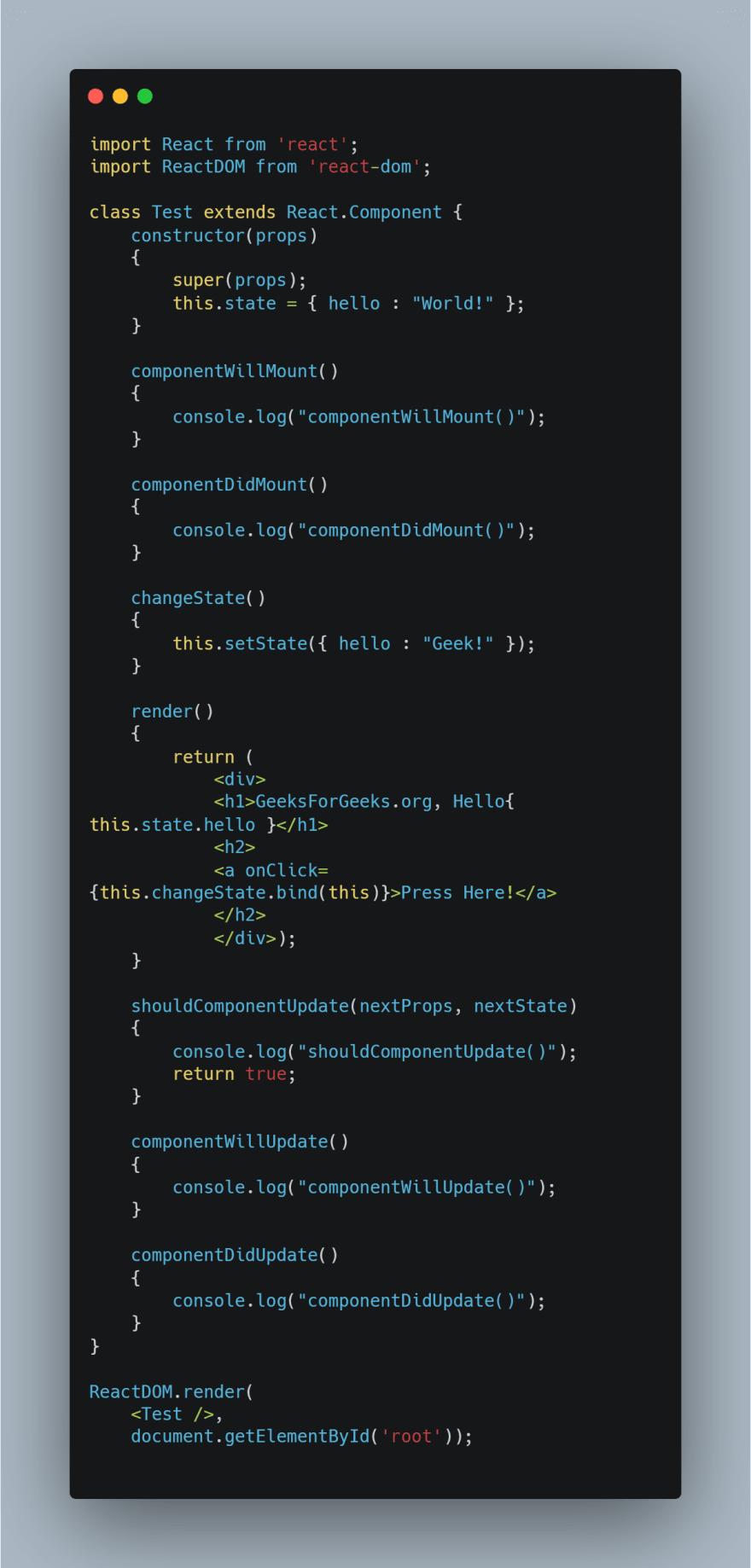
Handling Events in React JS
Handling events with React elements is very similar to handling events on DOM elements. There are some syntax differences:
React events are named using camelCase, rather than lowercase.
With JSX you pass a function as the event handler, rather than a string.
For example, the HTML:
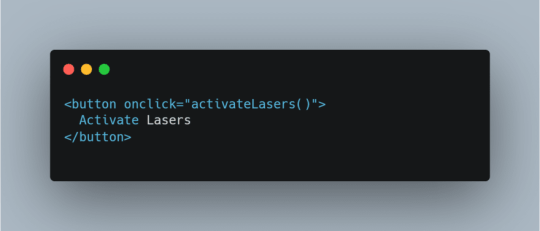
is slightly different in React:

Another difference is that you cannot return false to prevent default behavior in React. You must call preventDefault explicitly. For example, with plain HTML, to prevent the default link behavior of opening a new page, you can write:
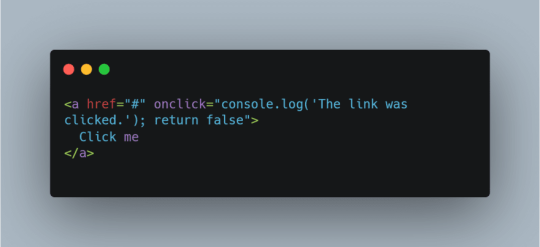
In React, this could instead be:

Here, e is a synthetic event. React defines these synthetic events according to the W3C spec, so you don’t need to worry about cross-browser compatibility.
When using React, you generally don’t need to call addEventListener to add listeners to a DOM element after it is created. Instead, just provide a listener when the element is initially rendered.
Know more about Event Handling in React and passing arguments to it at Handling Events-React.
Conditional Rendering in React

While developing an application in React or any other JS library/ framework, it is a common use case to show or hide elements based on certain conditions. It can be a simple user interaction — say, we need to show a popup when a user clicks a certain button and hide it when (s)he clicks the cross icon. To quote another example, think authentication — we make a ‘log out’ button visible when (s)he is logged in and make ‘Login/Sign up’ form visible for the opposite situation. This process of executing logic or rendering UI elements basis certain conditions is called conditional rendering.
Conditional rendering in React can be carried out using the following methods:
if/else
Ternary operation
Inline IF with Logical && operator
Switch case operator
Higher-Order Components
if/else
Conditional rendering in React works the same way conditions work in JavaScript. Use JavaScript operators like if, and let React update the UI to match them. We use an if with our condition and return the element to be rendered.

The LoggedStatus component displays either of these components depending on whether a user is logged in or not. A different greeting is rendered depending on the value of isLoggedInprop.
Ternary operation
The conditional (ternary) operator is the only JavaScript operator that takes three operands. This operator is frequently used as a shortcut for the if statement. When condition evaluates to true, the operator returns “This is True”; otherwise (when the condition is false) it returns “This is False”.

Implementation in React JS:
Consider this use case — Show an “Update” button when an edit has been made, else, show the “Edit” button.
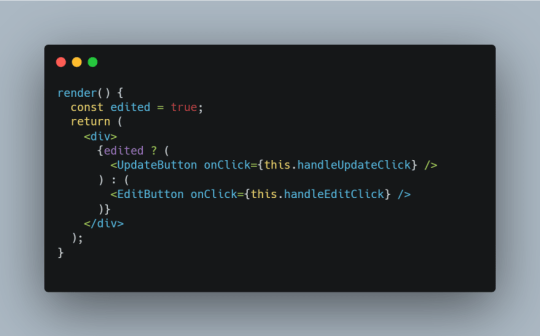
In the above example, when “edited” is true, we’ll show the “Update” button to the user. If “edited” is false, the “Edit” button is rendered.
Inline If with Logical && Operator
&& is a boolean operator, which essentially means “and”. For the condition to evaluate to true, both of the statements must be individually true. Below is an interesting example. Let’s say we want to render a message saying “You have X tasks to do”. When there are no pending tasks, no message should be displayed.

Observe carefully — When the length of the array is 3 (which is > 0), we’ll print, “You have 3 Tasks to do.” If the length is 0, we print nothing.
Switch Case operator in React
We can write switch case inline just like normal Javascript for conditional rendering in React. However, you would need a self-invoking JavaScript function.

Note carefully though that you always have to use default for the switch case operator since, in React, a component always needs to return an element or null.
To make it cleaner, we can get the switch out of the render in a function and just call it passing the params we want.

The switch case operator helps us to have multiple conditional renderings.
Higher Order Components
Higher order components or HOCs are often considered a difficult pattern to grasp in ReactJS. HOCs can be used for multiple use cases, however, in this article, we’ll be picking up HOC for conditional rendering.
HOCs are a perfect match for conditional rendering in React and can have several use cases. One of them can be to alter the look of a component. To make it more specific, it can be used to conditionally render the component itself.
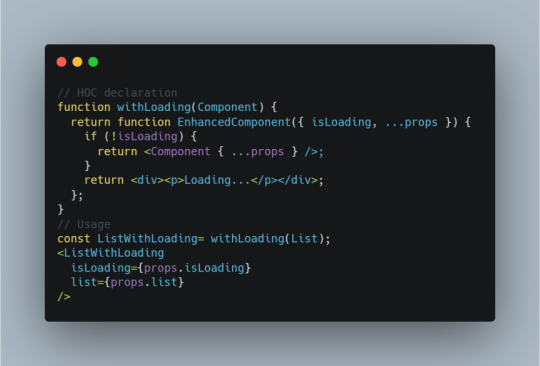
In the above example, the List component can focus on rendering the list. It doesn’t have to bother about a loading state. Ultimately, we could add more HOCs to shield away multiple conditional rendering edge cases.
Building and Deploying a React App
Everything we’ve learned so far has been in a development environment. We’ve been compiling, hot-reloading, and updating on the fly. For production, we’re going to want to have static files loading in and none of the source code. We can do this by making a build and deploying it.
Now, if you just want to compile all the React code and place it in the root of a directory somewhere, all you need to do is run the following line:

This will create a build folder that will contain your app. Put the contents of that folder anywhere, and you’re done!
0 notes